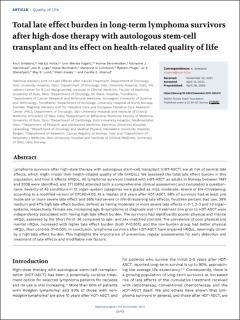| dc.contributor.author | Smeland, Knut Bjøro | |
| dc.contributor.author | Holte, Harald | |
| dc.contributor.author | Fagerli, Unn-Merete | |
| dc.contributor.author | Bersvendsen, Hanne Skjerven | |
| dc.contributor.author | Hjermstad, Marianne Jensen | |
| dc.contributor.author | Loge, Jon Håvard | |
| dc.contributor.author | Murbræch, Klaus | |
| dc.contributor.author | Linnsund, Marianne Dahl | |
| dc.contributor.author | Fluge, Øystein | |
| dc.contributor.author | Stenehjem, Jo Steinson | |
| dc.contributor.author | Samersaw-Lund, May Brit | |
| dc.contributor.author | Kvaløy, Stein Olav | |
| dc.contributor.author | Kiserud, Cecilie E. | |
| dc.date.accessioned | 2023-01-30T13:38:35Z | |
| dc.date.available | 2023-01-30T13:38:35Z | |
| dc.date.created | 2022-11-29T14:08:38Z | |
| dc.date.issued | 2022 | |
| dc.identifier.citation | Haematologica. 2022, 107 (11), 2698-2707. | en_US |
| dc.identifier.issn | 0390-6078 | |
| dc.identifier.uri | https://hdl.handle.net/11250/3047169 | |
| dc.description.abstract | Lymphoma survivors after high-dose therapy with autologous stem-cell transplant (HDT-ASCT) are at risk of several late effects, which might impair their health-related quality of life (HRQoL). We assessed the total late effect burden in this population, and how it affects HRQoL. All lymphoma survivors treated with HDT-ASCT as adults in Norway between 1987 and 2008 were identified, and 271 (68%) attended both a comprehensive clinical assessment and completed a questionnaire. Severity of 45 conditions in 12 organ-system categories were graded as mild, moderate, severe or life-threatening, according to a modified version of CTCAEv4.03. At a median of 8 years after HDT-ASCT, 98% of survivors had at least one moderate or more severe late effect and 56% had severe or life-threatening late effects. Fourteen percent had low, 39% medium and 47% high late effect burden, defined as having moderate or more severe late effects in 0-1, 2-3 and >3 organsystems, respectively. Female sex, increasing age, B-symptoms at diagnosis and >1 treatment line prior to HDT-ASCT were independently associated with having high late effect burden. The survivors had significantly poorer physical and mental HRQoL assessed by the Short Form-36 compared to age- and sex-matched controls. The prevalence of poor physical and mental HRQoL increased with higher late effect burden (both P<0.001), and the low burden group had better physical HRQoL than controls (P<0.001). In conclusion, lymphoma survivors after HDT-ASCT have impaired HRQoL, seemingly driven by a high late effect burden. This highlights the importance of prevention, regular assessments for early detection and treatment of late effects and modifiable risk factors. | en_US |
| dc.language.iso | eng | en_US |
| dc.publisher | Ferrata Storti Foundation | en_US |
| dc.rights | Navngivelse-Ikkekommersiell 4.0 Internasjonal | * |
| dc.rights.uri | http://creativecommons.org/licenses/by-nc/4.0/deed.no | * |
| dc.title | Total late effect burden in long-term lymphoma survivors after high-dose therapy with autologous stem-cell transplant and its effect on health-related quality of life | en_US |
| dc.title.alternative | Total late effect burden in long-term lymphoma survivors after high-dose therapy with autologous stem-cell transplant and its effect on health-related quality of life | en_US |
| dc.type | Peer reviewed | en_US |
| dc.type | Journal article | en_US |
| dc.description.version | publishedVersion | en_US |
| dc.source.pagenumber | 2698-2707 | en_US |
| dc.source.volume | 107 | en_US |
| dc.source.journal | Haematologica | en_US |
| dc.source.issue | 11 | en_US |
| dc.identifier.doi | 10.3324/haematol.2021.280413 | |
| dc.identifier.cristin | 2084173 | |
| cristin.ispublished | true | |
| cristin.fulltext | original | |
| cristin.qualitycode | 2 | |

